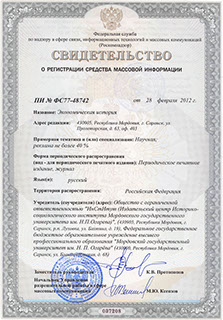Экономическая историЯ
Russian Journal of Economic History
ISSN 2409-630X (Print)
ISSN 2618-916X (Online)
Expert board:
- Scientific Council of RAS on economic history;
- Research and Educational Center «The economic history of Central Russia and the Middle Volga region» of Ogarev Mordovia State University;
- Center of Economic History of Lomonosov Moscow State University
Navigation
Certificate of registration

ISSN 2409-630X (Print), ISSN 2618-916X (Online)
DOI: 10.15507/2409-630X.054.017.202103.227-236
Tatyana I. Shcherbakova
National Research Mordovian State University (Saransk, Russia),
e-mail: tatyana_shcherbakova@bk.ru
Formation of a New Economic Model in the Post-Stalinist Soviet Union
Introduction. The article is devoted to the change of economic model in the post-Stalinist USSR. It considers measures through which this model was implemented, its consequences, features and social results are distinguished. Materials and Methods. The results of research are based on statistic of the USSR State Bank and analytical reports of experts published in the issues of edition “On the pages of archival funds of the Central Bank of the Russian Federation”. The author examines the dynamic and problems of money circulation, the social and economic contradictions generated by them. Results. The transition to the inflationary model began with a political course to reject from limiting population monetary income. In 1953–1970, in various forms, the monetary incomes of citizens, including the rural population, low-income, socially unprotected, were significantly increased. These measures led to negative processes in money circulation, to which experts of the State Bank drew the attention of the country’s leadership for a long period. Among them there were: the monetary growth, outpacing the growth in the production of consumer goods and the possibilities of goods turnover; the growth of public deposits in savings bank reflecting unmet demand for consumer goods; the use of public deposits to maintain the solvency of the country’s budget; increasing of the emission. Discussions. The inflationary economic model, implemented in a centralized planning system, had visible features. First, inflation in this model was not accompanied with price increases; secondly, the emission of money was the base for raising the standard of living of the population; thirdly, in this model the social stratification between ordinary citizens and the elite was intensified; fourthly, with transit to the inflationary model the shadow economy got the development. Conclusion. The transition in the USSR to an inflationary economic model improved standards of living in the USSR but predetermined the inevitable economic crisis in the foreseeable future with a high probability of the destruction of socialism.
Keywords: Soviet economy, money circulation, inflation, consumer goods, commodity deficit, unmet demand.
For citation: Shcherbakova T. I. Formation of a New Economic Model in the Post-Stalinist Soviet Union. Ekonomicheskaya istoriya = Russian Journal of Economic History. 2021; 17(3): 227–236. (In Russ.). DOI: 10.15507/2409-630X.054.017.202103.227-236.
© Ogarev Mordovia State University. History and Sociology Institute, 2017
68, Of. 411, Bolshevistskaya St., 430005, The editorial office of the scholarly journal «Russian Journal of Economic History»
Tel.: (8342) 24-25-90; 27-07-11, Fax: (8342) 24-25-90, E-mail: jurnal-econom-hist@isi.mrsu.ru
Designed by A. Napalkov, Email: napalkov@isi.mrsu.ru

